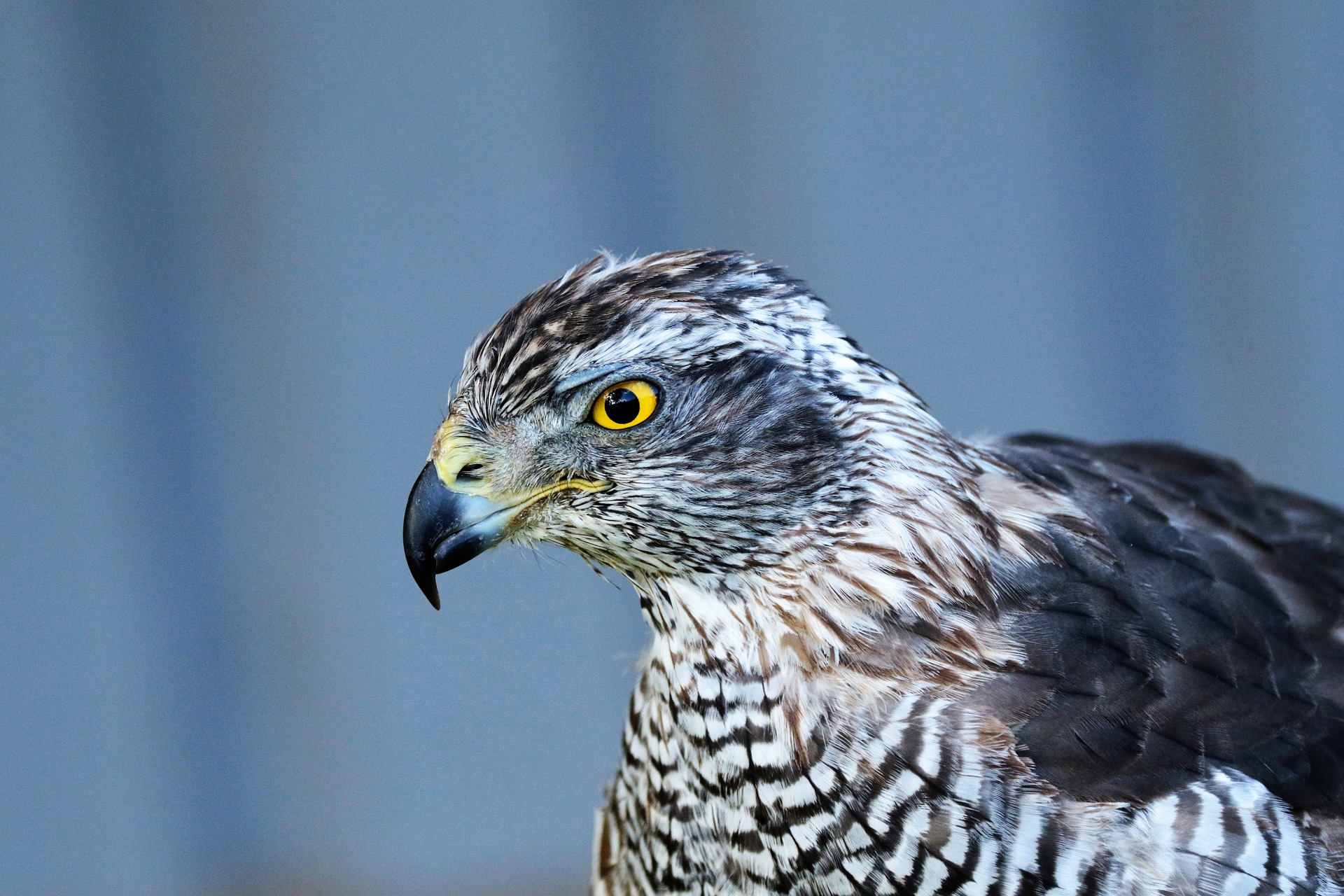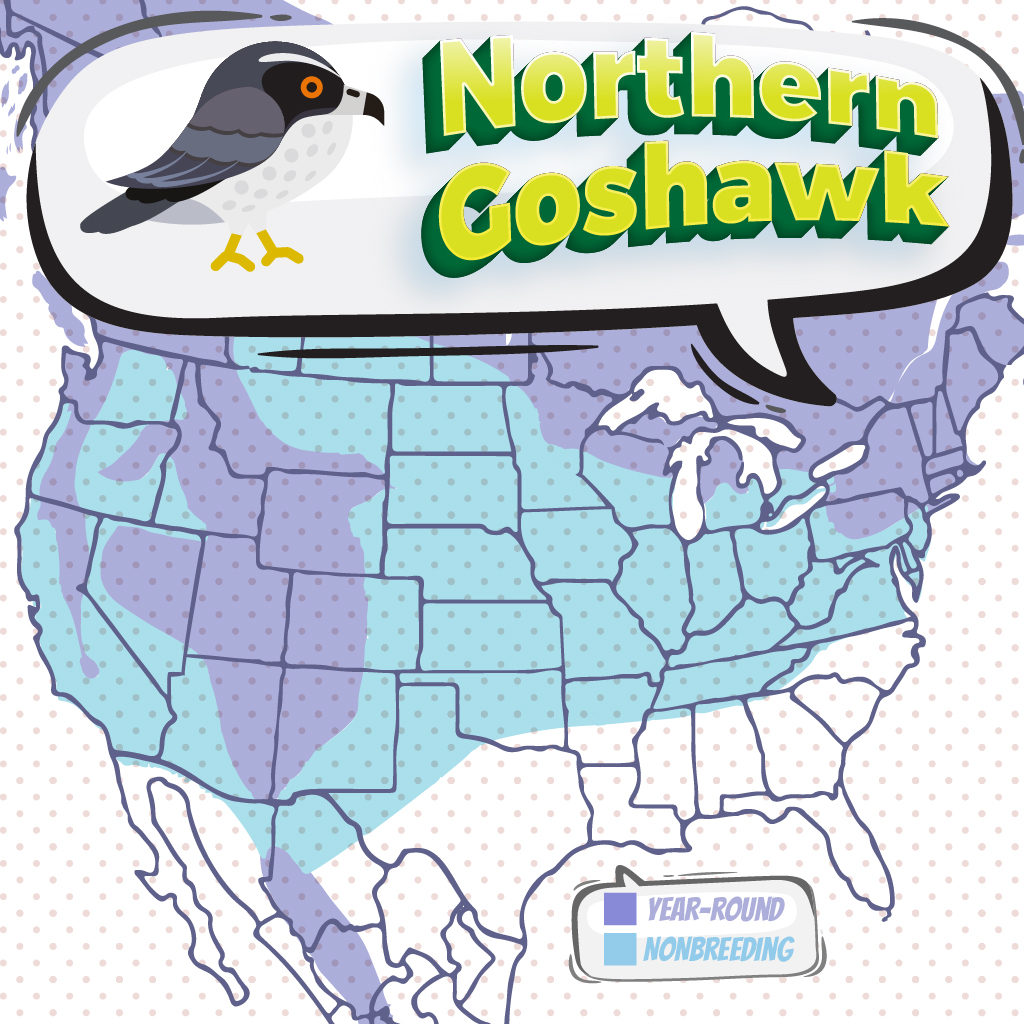
Northern Goshawk
A Northern Goshawk is a fun bird to see while bird watching. Below are some tips to help you identify Northern Goshawks. We have also put together a list of fun Northern Goshawk t-shirts, Northern Goshawk bird patches, birdhouses, bird feeders, binoculars, stickers, and other fun bird-watching items.
About Northern Goshawks
The Northern Goshawk is the only species of hawks found in Eurasia and North America. Its name translates to “to grasp gently”. It is considered as one of the species of true hawks.
Description and Identification
These raptors are large hawks and are the bulkiest of the accipiter genus with a body length
of 21 – 25 inches. They have broad, rounded wings and elongated tails that aid them in
maneuvering through forest terrains, often bearing a curved look due to long secondary flight
feathers. Their wingtips look pointed in flight and can span across 40.5 – 46 inches
approximately. Adults usually have slate-gray plumages with barred, gray underparts. These
birds can show color variations in their plumages depending on where they reside. Birds
further up north tend to have light-colored plumages while the ones in the south have
darker plumages, although this sort of coloration is not a consistent reality. Their heads are
dark with wide white strips over their orange to red eyes. Like many other species, the
females are significantly heavier than the males. The juveniles are brown with dark streaks
and narrow, dark bands on their tails; they have yellow eyes pale eyebrow stripes.
Northern Goshawk Size
Males: Length: 46 to 61 cm, Wingspan: 89 to 105 cm
Females: Length: 58 to 69 cm, Wingspan: 108 to 127 cm
The weight range across all the goshawks is 357 to 1200 g.

Northern Goshawk Color Pattern
It is blue-gray or brown-gray above and white on it is undersides. It has whitish streaks on top. The juveniles are solid to mild brown above with heavy streaks and have undersides with a wide range of colors from pure white to cinnamon-brown.
Both juveniles and adults have long, forked tails with 3 to 5 black or dark brown bars.
Northern Goshawk Behavior
They are migratory birds and like all other birds, their movements are controlled by seasons. They live in pairs of a mated male and female and both take part in raising the young. Females do most of the incubating, turning the eggs every 30 to 60 minutes. The male also incubates the eggs in the early days of incubation then leaves the female to take over.
The male will bring food and drop it on a branch near the nest, leaving the female to prepare it for the younglings.
What Northern Goshawk Eat
These birds primarily feed on other birds, small mammals, reptiles, and sometimes insects.
Their main mammalian prey includes squirrels, snowshoe hares, jackrabbits, and cottontails
which they spot from perches and swoop down to catch. Large birds like Dusky, Sooty,
Spruce, Hairy Woodpeckers, Northern Flickers, and Ruffed Grouse also form a substantial part of their diets. They generally look for bird feathers on the forest floor that might indicate
low perching nests.
They are opportunistic birds of prey. They feed on small to medium-sized mammals and medium to large-sized birds that they encounter during flight. What they eat heavily depends on their habitat, as the variety can differ dramatically with nests that are just a few kilometers apart. They eat squirrels, rabbits, pigeons, grouses, thrushes, and woodpeckers.
Even though their prey varies, they don’t eat fish nor insects.
Where Northern Goshawks Live
Northern Goshawks prefer nesting in heavily forested areas along regions with deciduous or
coniferous trees. These sites are far from human civilizations and tend to be selected near
open fields for ease in finding prey. Whether they are in coastal or alpine sites, the regions
they tend to gravitate towards have at least 60% canopies and are near water bodies like
creeks, lakes, or ponds. The kind of forests that they frequent include pine forests, aspen
groves, maples, birch, hemlock, and beeches. The range of habitat that they can be found in
is far more versatile during the winter than in the summer, where they tend to stick to the
forests along the Rockies.
Northern goshawks live in different places that include dense forests and shrubs. They generally live in warm areas that are close to their hunting grounds and hence prey.
Range and Migration

Northern Goshawks are medium-sized falcons found across North America and Eurasia.
These raptors owe their etymology to the Old English word “goose-hawk” due to their gentle
nature. They have an extensive range and were historically the falcons associated with
aristocracy. In North America, they are mainly found along the Rocky Mountains. Alaska,
western Canada, and the western United States. These areas constitute their breeding grounds
among forested regions. During the winter, most populations tend to stay within the regions
of their breeding grounds while some juveniles move southwards towards the southern United
States and parts of Mexico. Some adult birds also head south if there are limited prey in their
breeding grounds.
Northern Goshawks Nesting
The largest trees in a stand are chosen to build nests in, ranging from maple, oak, and
aspen trees in the east to fir trees in the west. The nesting sites are chosen by the females
during courtship and are carefully constructed during the nesting period. Small sticks are
gathered from the forest floor and are broken to be less than an inch in length in order to be
used in making the structure for the nests. These structures are then stuffed with leaves and
other vegetation to provide insulation and can go up to 2 feet in length and height. The
incubation period for 2 – 4 eggs in a brood usually lasts for around a month.
Ornithology
Bird Watching Academy & Camp Subscription Boxes
At Bird Watching Academy & Camp we help kids, youth, and adults get excited and involved in bird watching. We have several monthly subscription boxes that you can subscribe to. Our monthly subscription boxes help kids, youth, and adults learn about birds, bird watching, and bird conservation.
Bird Watching Binoculars for Identifying Northern Goshawks
The most common types of bird watching binoculars for viewing Northern Goshawks are 8×21 binoculars and 10×42 binoculars. Bird Watching Academy & Camp sells really nice 8×21 binoculars and 10×42 binoculars. You can view and purchase them here.
Northern Goshawk T-shirts
If you love the Northern Goshawk you should purchase a Bird Watching Academy & Camp T-shirt. To help support bird conservation we donate 10 percent to bird conservation activities.
Northern Goshawk Iron On Patches
Kids, Youth, and Adults love to collect our Bird Watching Academy & Camp iron-on patches. Our bird-watching patches help you keep track of the birds you have seen and identified. You can also display the patches on our Bird Watching Academy & Camp banners.
The Northern Goshawk is a great iron-on patch to start your collection with. The patches are durable and can be sewn on or ironed on to just about anything.
Northern Goshawk Stickers
Stickers are a great way for you to display your love for bird watching and the Northern Goshawk. We sell a monthly subscription sticker pack. The sticker packs have 12 bird stickers. These sticker packs will help your kids learn new birds every month.
Bird Feeders For Northern Goshawk
There are many types of bird feeders. Here are our favorite bird feeders for your backyard. We use all of these bird feeders currently. Kids will have a great time watching birds eat at these bird feeders. Using this collection of bird feeders will provide a wide variety and many types of birds.
Best Bird Houses for Northern Goshawk
There are many types of birdhouses. Building a birdhouse is always fun but can be frustrating. These 4 birdhouses have become our favorites. Getting a birdhouse for kids to watch birds grow is always fun. We spent a little extra money on these birdhouses but they have been worth the higher price and look great.











